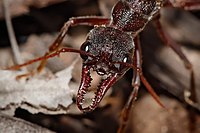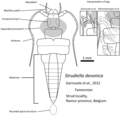Portal:Insects
The Insects Portal


Insects (from Latin insectum) are hexapod invertebrates of the class Insecta. They are the largest group within the arthropod phylum. Insects have a chitinous exoskeleton, a three-part body (head, thorax and abdomen), three pairs of jointed legs, compound eyes, and a pair of antennae. Insects are the most diverse group of animals, with more than a million described species; they represent more than half of all animal species. (Full article...)
Selected article -
Nothomyrmecia, also known as the dinosaur ant or dawn ant, is an extremely rare genus of ants consisting of a single species, Nothomyrmecia macrops. These ants live in South Australia, nesting in old-growth mallee woodland and Eucalyptus woodland. The full distribution of Nothomyrmecia has never been assessed, and it is unknown how widespread the species truly is; its potential range may be wider if it does favour old-growth mallee woodland. Possible threats to its survival include habitat destruction and climate change. Nothomyrmecia is most active when it is cold because workers encounter fewer competitors and predators such as Camponotus and Iridomyrmex, and it also increases hunting success. Thus, the increase of temperature may prevent them from foraging and very few areas would be suitable for the ant to live in. As a result, the IUCN lists the ant as Critically Endangered.
As a medium-sized ant, Nothomyrmecia measures 9.7–11 mm (0.38–0.43 in). Workers are monomorphic, showing little morphological differentiation among one another. Mature colonies are very small, with only 50 to 100 individuals in each nest. Workers are strictly nocturnal and are solitary foragers, collecting arthropod prey and sweet substances such as honeydew from scale insects and other Hemiptera. They rely on their vision to navigate and there is no evidence to suggest that the species use chemicals to communicate when foraging, but they do use chemical alarm signals. A queen ant will mate with one or more males and, during colony foundation, she will hunt for food until the brood have fully developed. Queens are univoltine (they produce just one generation of ants each year). Two queens may establish a colony together, but only one will remain once the first generation of workers has been reared. (Full article...)Did you know -
- ... that the cicada Aleeta curvicosta of eastern Australia is known as the floury baker from its appearance of being dusted with white powder?
- ... that a blister beetle was introduced in Hawaii to trim the wood-boring Sonoran carpenter bee population, but the beetle failed to survive in the islands?
- ... that the termite Globitermes sulphureus uses autothysis, a form of suicidal altruism, to entangle intruder ants in a sticky substance?
- ... that male Coastal Petaltails have unique, bright orange anal appendages called 'petaltails' that are believed to be used to attract a mate?
- ... that some beetles of the genus Zopherus are used as living brooches?
List articles
Related portals
General images -
Selected image -

The rose chafer Cetonia aurata (Coleoptera: Scarabaeidae) is a beetle, 20 mm (¾ in) long, that has metallic green coloration.
WikiProjects

Main WikiProject:
Related projects:
- WikiProject Arthropods
- WikiProject Spiders
- WikiProject Animals
- WikiProject Tree of Life
- WikiProject Biology
Daughter projects:
Tasks
 |
Here are some tasks awaiting attention:
|
Associated Wikimedia
The following Wikimedia Foundation sister projects provide more on this subject:
-
Commons
Free media repository -
Wikibooks
Free textbooks and manuals -
Wikidata
Free knowledge base -
Wikinews
Free-content news -
Wikiquote
Collection of quotations -
Wikisource
Free-content library -
Wikiversity
Free learning tools -
Wiktionary
Dictionary and thesaurus




















































